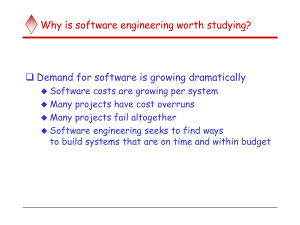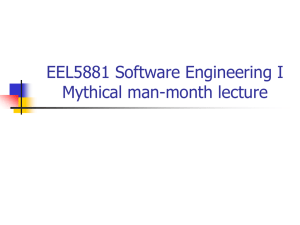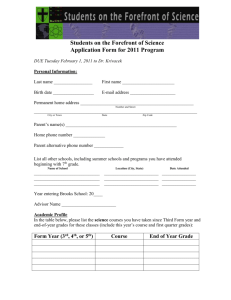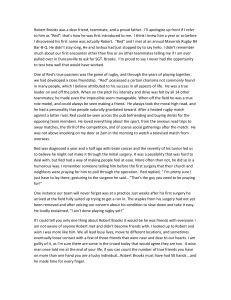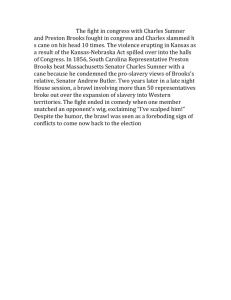Notes - Department of Electrical Engineering and Computing Systems
advertisement
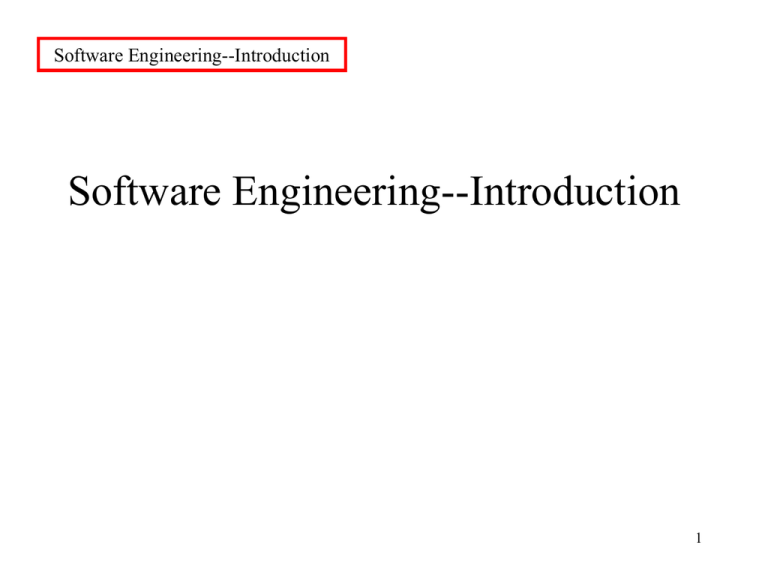
Software Engineering--Introduction Software Engineering--Introduction 1 Course Administration 1. Syllabus, grading, schedule--class + lab--will all be on www.ece.uc.edu/~cpurdy 2. Contact information: C. Purdy / Tao Ma (TA) 3. Java--to be learned in lab--you will develop basic skills, “expert” status not required 4. teams--3-4 per team (TURN IN SURVEY please) 5. project--most will be done in lab 6. passing 493/495: you must pass both classes; if you fail one, you will receive an F in both; otherwise you will receive a separate grade in each of these classes 7. grading: 493 | 495—explained on web pages 8. cell phones--for each call you get in class, you lose 3 points on your final grade 9. Electronic communication (text messages, laptops, etc.): NOT ALLOWED in lecture as these distract from class discussions 10. Reading assignments: please read BEFORE class & be ready to discuss in class (there may be quizzes for these) 11. Group work / individual work: we will do a lot of each--follow rules for each 2 assignment. Course Themes The lectures and assignments in this course will focus on developing knowledge and skills for: • effective teamwork • project management • software development • "lifelong learning" In this course we will be concentrating on the process of developing software, not on technical skills in specialized areas such as database management, wireless computing, etc. The skills we will learn can also be applied to hardware projects and to mixed hardware / software projects. 3 People, Product, Process--> Project what is "software engineering"?: the "art" of building and maintaining software systems "…software engineering is a discipline whose aim is the production of fault-free software, delivered on time and within budget, that satisfies the user’s needs.” Schach, Object-Oriented and Classical Software Engineering, 5th ed., Mc-Graw-Hill 2002, p. 4 4 People, Product, Process--> Project Importance of “fault-free” … Software bugs can be lethal. • The 2003 North America blackout was triggered by a local outage that went undetected due to a race condition – 55 million people were without power • Smart ship USS Yorktown was left dead in the water in 1997 for nearly 3 hours after a divide by zero error • Y2K problem … similarly 2038 problem … many Unix systems calculate the time in seconds since 1 January 1970, and store this figure as a 32-bit signed integer, for which the maximum possible value is 231-1 (2,147,483,647). 5 People, Product, Process--> Project "…software engineering is a discipline whose aim is the production of fault-free software, delivered on time and within budget, that satisfies the user’s needs.” Schach, Object-Oriented and Classical Software Engineering, 5th ed., Mc-Graw-Hill 2002, p. 4 components of software system construction (“4 P’s”): people • product • process • project • 6 Software Life Cycle "software life cycle": easier specify requirements (cheaper) (levels:1. functional to fix 2. performance mistakes (time/space) 3. implementation 4. use 5. maintenance) analyze requirements design implement harder to fix test mistakes maintain these steps are not independent; process is not "linear"--we will look at some "process models" for this cycle 7 People (Stakeholders)—Roles, Goals, Functions Role Responsibility Customer High level requirements, project scope User What tasks must system carry out? What is level of expertise? Software salesperson Get requirements; delivery dates, cost Business Manager Organize, track work Technical Manager Manage technical issues Developer Design, implement, test Technical WriterDocumentation, manuals Goals / Functions – conflicts? 8 Questions to Think About some points to ponder: •"software crisis"--systems become more and more complex: --what can we automate? --how can we verify/ test such complex systems? •"hardware/software" boundary --how can we do "co-design"? --where is the boundary? •types of software systems --how do important application-specific systems differ? --what impact do differences have on development? --which systems will be most important in the coming years? 9 Important System Types Some Common System Types—what is the same/different? •Databases •Communication systems •Entertainment systems •Web-based applications •Medical systems •Manufacturing / transportation systems •Simulation programs to support engineering and science •Parallel/distributed applications •Embedded systems •Intelligent systems / robots http://www.youtube.com/watch?v=7fYMxaBTqls •Utility software for computer systems (compilers, e.g.) •Utility software for general users (spreadsheets, e.g.) 10 References some references: 1. Fred Brooks, The Mythical Man-Month, Addison-Wesley, 1995 edition (this is THE classic reference on software engineering; first edition was published in 1974) 2. Scott Adams, Dilbert--sometimes cynical but often insightful perspective (e.g., the COBOL dinosaur; "Powerpoint poisoning") 3. Ed Yourdon, Death March, The Complete Software Developer's Guide to Surviving "Mission Impossible" Projects, Prentice-Hall, 1997. 4. Tom DeMarco, The Deadline, Dorset House Publishing, 1997--"Mr. Tompkins" for software 11 Dilbert 12 Dilbert – Powerpoint Poisoning 13 Mythical Man-month 14 “Mythical Man-Month” Some comments on Brooks' The Mythical Man-Month: Who is Fred Brooks? IBM architect, system developer; led OS/360 development Turing Award winner "Brooks' Law": adding manpower to a late software project makes it later updated Brooks' Law: adding personnel to a late software project makes it later 15 Why is Managing Programming Hard? Brooks attempts to answer the question: "why is programming so hard to manage?" brief answer: large programming projects suffer management problems different in kind from small ones, due to division of labor critical need: preserve the conceptual integrity of the product itself In 1995 edition Brooks asserts: "I was struck by how few of the propositions asserted in it have been critiqued, proven, or disproven by ongoing software engineering research and experience" 16 System Architect what are these propositions? (excerpts): I. Architect: conceptual integrity of the product is paramount; "the product must be conceptually coherent to the single mind of the user and at the same time designed by many minds" most important is "the commissioning of some one mind to be the product's architect, . . . responsible for the conceptual integrity of all aspects of the product perceivable by the user" 17 Separate Architecture, Implementation except in very small projects, architect cannot also be manager architect director manager producer architecture and implementation must be separated large systems need subsystems with subarchitects 18 Process Model II. Process model: "Don't build one to throw away--the waterfall model is wrong" incremental build, progressive refinement are more productive techniques 19 Productivity III. Productivity: information hiding is the way to go (a changed opinion from edition 1) the "man-month" really is mythical (Brooks' Law is "true") people are (almost) everything in software productivity 20 What did we do today? •Welcome to class – (and… turn in your surveys!) •It’s a “process course” -- teamwork, methodology, lifelong learning ALL in the context of good code development •The 4 P’s -- people, product , process, project •Plethora of models … plan, do, fix •Fred Brooks , et. al – Mythical Man Month 21
